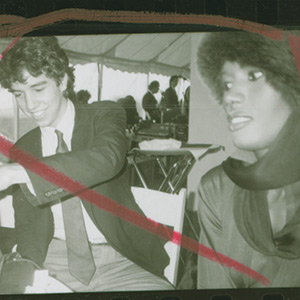

Andy Warhol took photographs that made the paparazzi turn emerald green with envy. He had something they would never possess—access. A photographer could snap a shot of an actress leaving a nightclub, but he’d never capture the sultry, unashamed expression of Debbie Harry, nude but thoughtfully cropped, the way that Warhol does in one of his many polaroid portraits. In “Warhol Unframed,” a small exhibit at the Cantor Arts Center, some of the artist’s lesser known photographs, contact sheets and silkscreen prints are currently on display.
The recurring story that emerges from the exhibit is that he lived, worked and played with and amongst celebrities. Warhol embraced these cultural luminaries, oftentimes his friends, and transformed them with his documentarian tendency to record every minute of his life.
Grace Jones, the singer, actress and former model, appears in a 1986 gelatin print at the Schwarzenegger-Shriver wedding reception. She’s watching “a Kennedy” submerge his fingers, and an unidentifiable object, into a water glass. Her fur-lined hat is cropped to the top edges of the frame. Jones, who has been photographed hundreds if not thousands of times for public consumption, seldom if ever displays bewilderment.
Before the advent of social media, before celebrities talked back to us, Warhol infected his art with glamor and exclusivity. His eye persuades the viewer that there is world of difference, and distance, between the beautiful people dancing inside the wedding tent and the rest of us, who simply gaze at the pictures in a glossy magazine while sitting on the fubsy sofa. This vision that Warhol once cast holds true—you’re still not invited to the party—but the audience has grown numb and indifferent to his message. Because the message, like some radical self-replicating spore, has long since outgrown the medium, saturating every aspect of American culture, pop or otherwise.
There is no greater example of this saturation point than the silkscreen print of the late actress Elizabeth Taylor in Liz, 1964, also part of the exhibit. What reality show star doesn’t have those Warholian portraits of themselves, in garish primary colors, hanging on their living room wall? It doesn’t matter if you’ve accomplished anything other than being on TV. What matters is that you can afford the appearance of accomplishment. Appearance for appearance’s sake, it’s the winning endgame of reality stars everywhere.
Warhol Unframed
Thru May 1, 2017
Cantor Arts Center, Stanford


